Yoga with Youth attending the Summer Adventure Camp at Vision Resources of Central Pennsylvania on June 23, 2015. A great group!

Yoga with Youth attending the Summer Adventure Camp at Vision Resources of Central Pennsylvania on June 23, 2015. A great group!

Below are some images from Yoga 4 Summer Solstice class at Loaves and Fishes Farm in Dover, PA on Saturday, June 20, 2015.
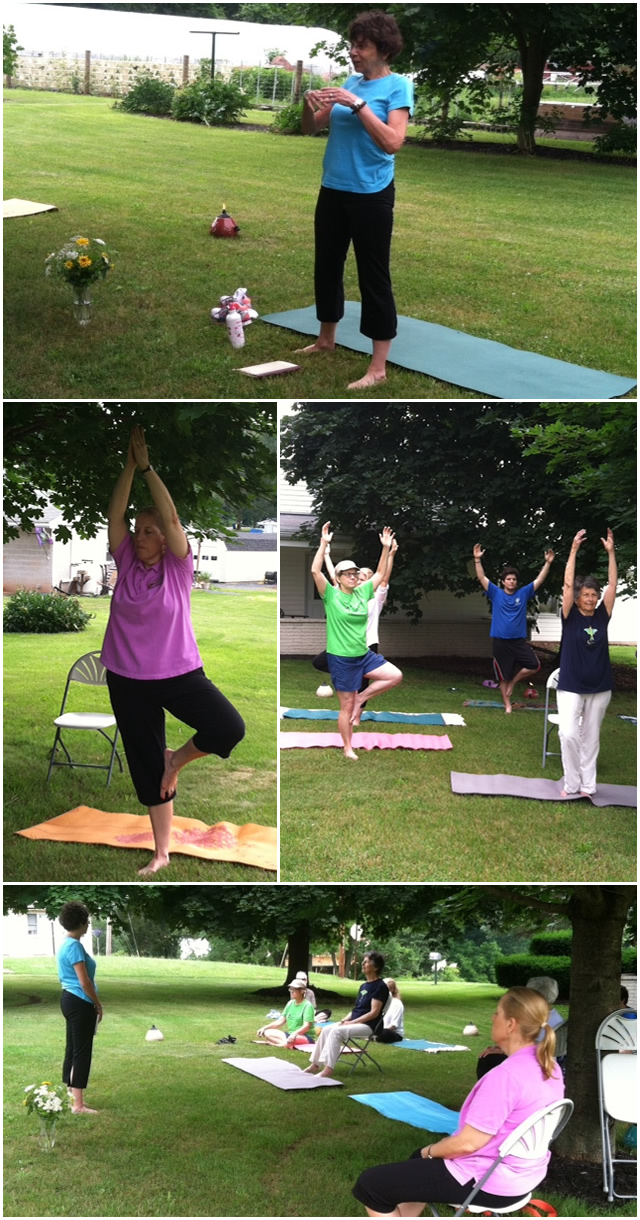
Note: Joy is one of our eleven Benefits of Yoga
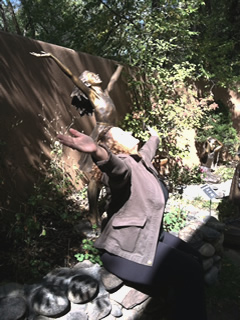 Yoga identifies five dimensions in our human system: the physical or annamaya, the energetic or pranamaya, the intellect or manomaya, the personality or vijnanamaya, and the emotional or anandamaya. The word ananda, in the emotional dimension, is translated as “joy that never stops.” This level of our system is capable of joy because it is not linked to habitual ways of thinking that cause suffering.
Yoga identifies five dimensions in our human system: the physical or annamaya, the energetic or pranamaya, the intellect or manomaya, the personality or vijnanamaya, and the emotional or anandamaya. The word ananda, in the emotional dimension, is translated as “joy that never stops.” This level of our system is capable of joy because it is not linked to habitual ways of thinking that cause suffering.
Habitual patterns of thoughts may be things such as ruminating over regrets about something in the past, or thoughts of failure because we have less than our friends, or fears about our future or our children’s future. When our minds our engaged in these kinds of negative thoughts, we feel constricted, ill at ease: we cannot experience joy.
Since yoga acts on all the different parts of our human system, doing postures, simple breathing techniques, and using sound or other tools of yoga can allow us to see negative patterns of thought and help free us from them and the frustration and unhappiness they engender. Over time, an appropriate, regular yoga practice helps us to see those things creating “non-joy” so we may let go of them, and those things linking us to that joy inherent within us. Through our yoga practice, we can choose to move toward what is positive, toward what nourishes joy at our deepest level.

Earlier this week, before the weather turned chilly, I took a rest from cleaning up weeds and detritus around the two crepe myrtle by our driveway. Their fushia flowers had brought us great pleasure during the summer, but what remained now, in November, was just browning and falling leaves.
Leaning my arms on the trunk of the car, I looked toward the creek, to the old sycamore whose boney branches rose above the rooftops, glowing in a slant of sunlight. But my gaze was stolen from the tree by the motion of hawks. Two hawks circled in similar flight paths, at different heights, riding the thermals as they flapped and coasted, flapped and coasted. Banking to maintain their circle the angle of their bodies shifted, and sunlight flashed across their creamy white bellies.
Sycamores, hawks, light.
“Light originates in the center of the heart,” explains Bernard Bouanchaud in his commentary on yoga sutra I.36. Meditating on that light, which is believed to be the source of the divine within, brings a sense of serenity.
This concept is very precious to me, personally. At a time when I was struggling with a lack of confidence and a feeling of distress, my yoga teacher said to me, “Your light is so bright. You just cannot see it.” Her words were a gift, something I return to for solace and stability.
We all experience times when we feel as if we are in a dark space. That is why I offer this image of the light in the heart to my students as focus in class from time to time. When we are caught in a dark space in our thinking, we can visualize the image of the light within. As flicking a switch in a dark room dissipates the darkness that had been there, linking to the image of a light in the heart can help dissipate the darkness of our thoughts.
The ancient Vedas offer a beautiful image that can help us explore this mystery of the light in the heart.
In the body is the heart,
In the heart is a lotus,
In the lotus is a light,
This light is the source of inner peace…”
According to Bouanchaud’s commentary, meditating on the luminous quality of the heart offers us the possibility of more than a sense of peace and stability, as wonderful as that is. This serenity can open a door connecting us to “the life that animates all beings and everything in nature” and encouraging “a deep relationship with it.”
As I watched the light flash on the bellies of the circling hawks and gleam on the white skin of the sycamore, I was reminded of the light living not only within me, but within all people, all beings. The promise of peace and connection is there for all of us, if only we notice.
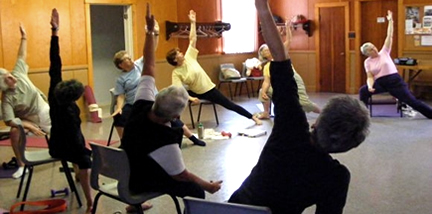
A woman I know was clearly annoyed observing a Chair Yoga class at her gym when she told me “those people need to get up and move.” Her comment made me wonder about the misconceptions people may have about a Chair Yoga class.
Participants in the Chair Yoga for Seniors class I teach range in age from late 60s to early 90s. While they can stand for some poses, some using the chair for stability, they are not getting down on the floor. But they want the benefits of improved stability, flexibility and balance in their bodies, self-awareness and clarity in their minds, and a sense of calm and balance at the level of emotions. They want to worry less and enjoy their lives more.
An understanding of yoga postures or asana can be helpful in understanding the value of what can be done in a Chair Yoga class. Yoga postures are divided into categories based upon their functions. For example, the function of bending forward in a posture is to stretch the back. The function of a back-arching pose is to stretch the front of the body; a twist twists the spine; a lateral pose stretches the sides of the body. As we work in postures in Chair Yoga, we need to achieve the function of the classical postures in a modified context.
Let’s keep this in mind: if someone 70 years old has a stiff back and legs, gently bending forward while seated will stretch the back. The function of the pose can be achieved even though the form differs from the classic form of bending forward standing, legs straight, hands on the floor. In fact, trying to achieve this form could cause injury to the person with such stiffness.
When people assume that someone should move a certain way to be doing yoga, they are missing the point. When a person using the breath in a way that supports that function and moves prana or energy. By connecting the mind and body through movement, the mind begins to focus. Awareness develops as the participants are given time to observe the effects of what they have done. Additional work is done as they sit with an assigned breathing practice to steady breath and mind.
The point I want to make is, depending upon the audience, a Chair Yoga can offer the benefits of regular yoga class. In form it may not look as demanding as the posture done classically, but it might be accomplishing the same benefit based upon condition of the person doing the posture. We have to remember that we are all different. There is no one yoga practice to fit all people at every age. But there is a yoga for everyone and every body.
Chair Yoga is a gentle, non-traditional form of Yoga that reduces strain on limbs and joints. Participants are guided in postures, breathwork, and meditation. Postures may be done in the chair and/or standing with the support of the chair. This practice promotes stability and flexibility at the level of the body, self-awareness and clarity at the level of the mind, a sense of calm and balance at the level of the emotions, and overall wellness
Chair Yoga at Susquehanna Township Recreation Building meets Thursdays from 11:00 am to noon. Please contact me at eterryyoga@gmail.com or call 717-645-0067 for more information or to sign-up.
Support for those who are grieving
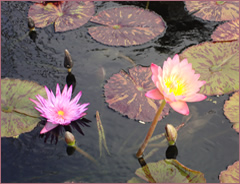 The experience of loss is always about change – struggling with and finally accepting change on many levels. Yoga, as a discipline and a philosophy, is also about acceptance of what is – of who we are, of the situation we are in, and of the circumstances that brought us to this point. Through the physical and mental practice that is yoga we can learn to apply principles of acceptance to all areas of life.
The experience of loss is always about change – struggling with and finally accepting change on many levels. Yoga, as a discipline and a philosophy, is also about acceptance of what is – of who we are, of the situation we are in, and of the circumstances that brought us to this point. Through the physical and mental practice that is yoga we can learn to apply principles of acceptance to all areas of life.
This five session series of gentle yoga will provide a safe space in which participants can begin to make peace with both the pain and the changes that loss contains. All levels of physical ability will be welcome in the group.
Thursdays, September 5-October 3, 2013, 2:00-3:30 pm
TMC: wellness through movement
2134 N. 2nd St.
Harrisburg, PA 17110
Facilitated by:
Jennilu King, Grief Counselor
Elizabeth Terry, Yoga Teacher
Cost: $35 for the course.
Participants will need to have a yoga mat.
Contact Elizabeth Terry at 717-645-0067 or e-mail eterryyoga@gmail.com for more information or to register.
“Making peace with change is at the heart of every journey…”
– Paula D’Arcy
~
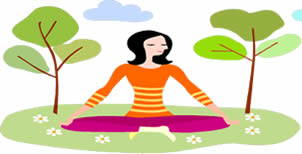
Saturday, June 22, 2013
Loaves and Fishes Farm
1810 York Road, Dover PA 17315
Yoga from 10:00-11:30am, followed by a farm tour, a light lunch, fun and fellowship!
Bring your own yoga mat, walking shoes and “farm friendly” clothes for playing with the goats. A free will offering will be accepted to support the work of Loaves and Fishes Farms.
Please reserve your spot by June 15, 2013:
Elizabeth Terry eterryyoga@gmail.com or (717) 645-0067
For more info on the farm, check out their Facebook page – Facebook.com/LoavesAndFishesFarm or contact:
Farmer Jen Briggs jenbriggs@comcast.net or (717) 774-0794
Farmer Bonnie McCann bonniejmccann@comcast.net or (717) 319-7721
Directions (from Harrisburg area)
Interstate 83 south to the Yocumtown Exit. At Light make a left and then an immediate Right on to Taylor Road. Follow that road for about 3.5 miles. You will cross over Rt. 382 (Lewisberry Road) which then becomes York Road, this is curvy and you will pass the Susquehanna Speedway and the farmer market on your left and you will pass a church and school on your right. The Loaves and Fishes Farm is on the corner of Red Bank and York Road. It is a white house with green shutters – the kitchen is in the garage (doesn’t everyone have a kitchen in the garage?)
1810 York Road
Dover, Pa 17315